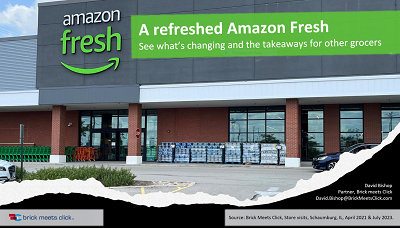Picnic's online grocery model: Regular-route delivery combined with mass market pricing
Complete the form below to instantly download this month's dashboard.

Picnic, the Dutch online grocery retailer founded in 2015,has developed a fast-growing, low-cost business model that is different from virtually all other grocery delivery services operating today. Two things set it apart. One, Picnic runs a regular delivery route instead of using on-demand delivery, and two, Picnic prices for the mass market – not the premium market. The synergy between these two things has propelled its rapid growth and driven profitable sales.
The cornerstone of the Picnic model is a system of regular delivery routes. The structural cost advantage that comes from using this regular “bus route” model instead of the on-demand “taxi model” allows it to capture major savings. In turn, these savings allow Picnic to offer free delivery and a more affordable price point which expands its customer pool.
Picnic then uses its expanding customer base to grow profitability: It builds waiting lists of interested consumers and adds routes only when there are enough customers to make the new route profitable. Consumers receive a small gift for each week they wait on the list, and the current list is reported to have several thousand people on it.
The net result is that Picnic has grown rapidly and is estimated to have gained 10% of Holland’s online market in just three years while operating in just a few communities. (Albert Heijn had 50% and Jumbo had30% in late 2018.) It has also expanded into several markets in Northern Germany as of mid 2018.
BMC POV
Picnic is doing a lot of things right and it shows in both their growth and profitability. At the top of the list is its positioning as a mass market delivery service – it has avoided premium pricing that would otherwise narrow its appeal.
The big advantage of this positioning is that it attracts enough consumer interest so that Picnic has long waiting lists which give them visibility into the demand they can expect from a new route before they open it.With this foresight, Picnic can almost ensure the profitability of new routes,and this reinforces the cornerstone of its business model.
Picnic can price for the mass market because of the savings,and these can serve as ideas for other online retailers looking to lower costs.
- The most important source of savings is that Picnic runs only regular routes with predictable sales; they don’t assume the higher cost of delivering on demand.
- The other big source of savings is that Picnic concentrates the assembly of orders in a small number of locations which is made possible because orders must be placed by 10 pm the day before delivery. Then they use a two-step distribution process to get the orders to the home. This centralization gives them the ability to:
- More intensely manage the efficiency of building the orders.
- Buy perishable products only after they know a customer has ordered them.
We’re aware of only a couple of online grocery retailers in the world that have achieved profitability with delivery – but the fact that this IS happening serves as an example that it can be done and will continue to spark innovations.
Thanks to Håkan Bengtsson for the sending this article to The Lookout.
Photo credit: Picnic
For a look into their operations, read this www.supermarektblog.com interview with Picnic Co-founder Michiel Muller.












